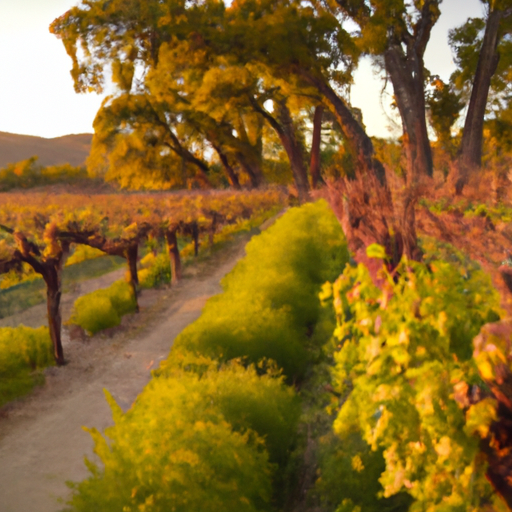Exploring the Untamed Flavors of Napa Valley’s Wines
The Rich History of Napa Valley’s Wine Culture
Nestled in the heart of California, Napa Valley is renowned for its exquisite wines and picturesque vineyards. The region’s wine culture has a rich history that dates back to the 19th century, when European immigrants first recognized the potential of the fertile land for grape cultivation. Today, Napa Valley is home to some of the world’s most celebrated wineries, attracting wine enthusiasts from all corners of the globe.
The story of Napa Valley’s wine culture begins with the arrival of George Calvert Yount in the early 1830s. Yount, a fur trapper turned farmer, recognized the region’s potential for grape growing and planted the first vineyard in what is now known as Yountville. His success inspired other settlers to follow suit, and soon, vineyards began to dot the landscape.
However, it was not until the 1860s that Napa Valley’s wine industry truly took off. Charles Krug, a German immigrant, established the first commercial winery in the region, introducing European winemaking techniques and elevating the quality of Napa Valley wines. Other pioneers, such as Gustave Niebaum and Jacob Beringer, soon followed suit, further cementing Napa Valley’s reputation as a premier wine-producing region.
The early 20th century brought both challenges and opportunities for Napa Valley’s wine industry. Prohibition, which lasted from 1920 to 1933, dealt a severe blow to winemakers, forcing many to abandon their vineyards or resort to producing sacramental wines. However, the end of Prohibition marked a turning point for Napa Valley, as winemakers began to experiment with new grape varieties and winemaking techniques.
In the 1960s and 1970s, Napa Valley experienced a renaissance that would forever change the landscape of the wine industry. A group of visionary winemakers, known as the “Judgment of Paris” participants, shocked the world by winning blind tastings against renowned French wines. This event put Napa Valley on the global wine map and solidified its reputation as a producer of world-class wines.
Today, Napa Valley is home to over 400 wineries, each with its own unique story and winemaking philosophy. From small family-owned vineyards to large-scale operations, the region offers a diverse range of wines that cater to every palate. Whether you prefer bold Cabernet Sauvignons, elegant Chardonnays, or vibrant Sauvignon Blancs, Napa Valley has something to offer.
The success of Napa Valley’s wine industry can be attributed to its unique combination of climate, soil, and winemaking expertise. The region’s Mediterranean climate, characterized by warm, dry summers and cool, wet winters, provides the ideal conditions for grape cultivation. The diverse soil types, ranging from volcanic ash to alluvial deposits, contribute to the complexity and character of Napa Valley wines. Additionally, the winemakers’ commitment to sustainable and organic practices ensures that the land and its resources are preserved for future generations.
In conclusion, Napa Valley’s wine culture is deeply rooted in its history and shaped by the passion and dedication of its winemakers. From humble beginnings to global recognition, the region has come a long way in establishing itself as a premier wine-producing destination. Whether you are a wine connoisseur or simply appreciate the art of winemaking, a visit to Napa Valley is sure to be a memorable experience, allowing you to explore the untamed flavors that have made this region a true wine lover’s paradise.
Unveiling the Hidden Gems: Lesser-Known Wineries in Napa Valley

Napa Valley is renowned for its world-class wines, attracting wine enthusiasts from all over the globe. While many visitors flock to the well-known wineries that have gained international acclaim, there is a hidden treasure trove of lesser-known wineries waiting to be discovered. These hidden gems offer a unique and untamed experience, allowing visitors to explore the diverse flavors and rich history of Napa Valley’s wines.
One such hidden gem is Smith-Madrone Vineyards, nestled high atop Spring Mountain. This family-owned winery has been producing exceptional wines since 1971, yet remains relatively unknown to the masses. The vineyard’s remote location and limited production ensure that each bottle is crafted with meticulous care and attention to detail. Visitors to Smith-Madrone can enjoy a personalized tasting experience, guided by the knowledgeable and passionate staff who are eager to share the story behind each wine.
Another hidden gem is Larkmead Vineyards, a historic winery with roots dating back to the late 1800s. Located in the heart of Napa Valley, Larkmead is known for its commitment to sustainable farming practices and its dedication to showcasing the unique terroir of the region. The winery’s small production allows for a hands-on approach, with the winemakers intimately involved in every step of the winemaking process. Visitors to Larkmead can explore the vineyards, learn about the winery’s sustainable practices, and taste the exquisite wines that have earned them a loyal following.
For those seeking a truly off-the-beaten-path experience, a visit to Tres Sabores is a must. This boutique winery is tucked away in the Rutherford appellation, surrounded by rolling hills and picturesque vineyards. Tres Sabores is known for its commitment to organic farming and its focus on producing small-batch, handcrafted wines. Visitors can take a leisurely stroll through the vineyards, learn about the winery’s organic practices, and savor the unique flavors of their limited-production wines.
One cannot explore the hidden gems of Napa Valley without mentioning Corison Winery. Founded by Cathy Corison in 1987, this winery has gained a cult following for its elegant and age-worthy Cabernet Sauvignon. Corison Winery is located in the heart of the St. Helena appellation, where the unique microclimate and volcanic soils contribute to the distinct character of their wines. Visitors to Corison can enjoy a tasting in the winery’s charming barn, surrounded by barrels and the intoxicating aroma of aging wine.
These lesser-known wineries offer a refreshing alternative to the crowded tasting rooms and tourist hotspots that dominate Napa Valley. They provide an opportunity to connect with the winemakers and learn about their craft in a more intimate setting. Whether you are a seasoned wine connoisseur or a curious novice, exploring the untamed flavors of Napa Valley’s hidden gems is sure to be a memorable and enriching experience. So, venture off the beaten path and uncover the secrets that lie within these lesser-known wineries – you may just discover your new favorite bottle of wine.
A Journey Through the Vineyards: Exploring Napa Valley’s Wine Tasting Experiences
Napa Valley, located in the heart of California’s wine country, is renowned for its world-class wines and picturesque vineyards. With its ideal climate and fertile soil, this region has become a haven for wine enthusiasts and connoisseurs alike. A journey through the vineyards of Napa Valley offers a unique and unforgettable wine tasting experience, allowing visitors to explore the untamed flavors that this region has to offer.
As you embark on your wine tasting adventure in Napa Valley, you will be greeted by a diverse range of vineyards, each with its own distinct character and charm. From the historic wineries that have been producing exceptional wines for generations to the boutique vineyards that offer a more intimate and personalized experience, there is something for everyone in Napa Valley.
One of the highlights of exploring Napa Valley’s wine tasting experiences is the opportunity to sample a wide variety of wines. From the classic Cabernet Sauvignon and Chardonnay to lesser-known varietals such as Zinfandel and Merlot, Napa Valley’s wineries offer a vast selection of wines to suit every palate. Whether you prefer bold and robust reds or crisp and refreshing whites, you are sure to find a wine that delights your taste buds.
In addition to the diverse range of wines, Napa Valley’s wineries also offer a range of tasting experiences to suit different preferences. Some wineries offer traditional tastings, where you can sample a selection of wines at the tasting room or bar. Others offer guided tours of their vineyards and production facilities, providing a behind-the-scenes look at the winemaking process. Some wineries even offer food and wine pairings, allowing you to savor the flavors of Napa Valley’s wines alongside delicious culinary creations.
As you explore the vineyards of Napa Valley, you will also have the opportunity to learn about the rich history and heritage of winemaking in this region. Many wineries have been family-owned and operated for generations, passing down their winemaking traditions and techniques from one generation to the next. By visiting these wineries, you can gain a deeper appreciation for the craftsmanship and dedication that goes into producing each bottle of wine.
Beyond the wine tasting experiences, Napa Valley also offers breathtaking scenery and a tranquil atmosphere that adds to the overall charm of the region. Rolling hills covered in vineyards, picturesque wineries nestled among the vines, and stunning views of the surrounding countryside create a truly idyllic setting for wine tasting. Whether you choose to explore the vineyards on foot, by bike, or even by hot air balloon, you are sure to be captivated by the beauty of Napa Valley.
In conclusion, a journey through the vineyards of Napa Valley offers a unique and unforgettable wine tasting experience. With its diverse range of vineyards, wide variety of wines, and range of tasting experiences, Napa Valley has something to offer every wine enthusiast. Whether you are a seasoned wine connoisseur or a novice looking to expand your palate, exploring the untamed flavors of Napa Valley’s wines is an experience not to be missed. So, raise your glass and embark on a journey through the vineyards of Napa Valley to discover the true essence of this world-renowned wine region.







